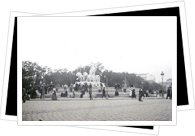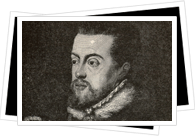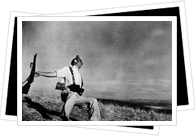Madrid History & People

Muslim Madrid (9th - 11th centuries)
The history of Madrid as we know it unfolds in the 9th century A.D., much later than Visigothic and Roman cities like Toledo and Sevilla. Madrid's geography and topography attracted Muslim settlers as they made their way north conquering the peninsula. They picked the spot where the Royal Palace now stands, on a flat, elevated craig overlooking the Sierra de Guadarrama, for its obvious tactical advantages. The area's abundant water source below inspired Arabs to name it "Mayrit" or "Magerit," meaning "place of many springs." Mayrit's proximity to Toledo, the capital city, facilitated trade and commerce as well.
Early Christians (11th - 16th centuries)
Mayrit was an unexceptional rural town and continued as such under Christian hands. Alfonso VI took back Toledo and its environs in the 11th century, however Muslims remained and contributed to medieval Madrid as builders, while Jews were tolerated but obliged to live outside the city walls in the Lavapiés neighborhood.

The Spanish Golden Age (late 16th - 17th centuries)
Madrid history took a drastic turn in 1561 when Phillip II decided to up and move his court to Madrid. Thus the capital of a burgeoning empire became a city with no cathedral, university or printing press. Most historians explain Phillip's unlikely decision in terms of Madrid's advantageous location smack in the center of the Iberian Peninsula. Or perhaps he favored Madrid as a neutral site without deep regional ties or history, where he could mold the kind of capital he wanted. In any case, Madrid quickly filled up with outsiders attending to the court's needs, and the population more than tripled in just 40 years.
The city grew too fast for its own good and filled with makeshift houses of mud with no draining system whatsoever. In other words, the greater Madrid grew, the smellier it got. Despite its unseemly appearance, Madrid did begin to appear more like a capital as money poured in from the New World -- albeit straight into the hands of the nobles. The 17th century marked Spain's Golden Age of literature and art, headed by playwrights Lope de Vega, Calderón de la Barca and Tirso de Molina, novelist Miguel de Cervantes and painter Diego Velazquez. You can see where many of these players lived in the present day "Barrio de las Letras," better known as Huertas.
Bourbon Expansion (18th - early 19th centuries)
King Charles III was the first to take a true interest in raising Madrid's status to that of other European capitals. He therefore began an ambitious expansion project inspired by Enlightenment ideals and Franco-Italian elegance (see Madrid architecture). In 1808, Napoleon installed his brother, Joseph Bonaparte, as the ruler of Spain and the masses rebelled. Many mark May 2, 1808, the date of the uprising, as the beginning of modern Spanish history, and it's still celebrated today during the Madrid festival of Dos de Mayo.

Instability, Civil War & Dictatorship (19th century - 1975)
From 1814 until the start of the Civil War in 1936, Spanish history was characterized by frequent changes in government. The Bourbons came and went, as did wars of succession, two Republics and 1 dictatorship. In 1898, Spain suffered a great identity crisis when it lost Cuba, the very last colony of its glorious empire. The Great Depression of the 1920s also hit Spain hard, and so over a century of turmoil and economic decline eventually culminated in Civil War. Madrid became a major front for Republican (leftist) resistance and when the city fell shortly after Barcelona in 1939, the war was officially called for Franco.
Francisco Franco's dictatorship was one of history's longest -- it lasted almost 40 years from 1939 to 1975. Those who had fought on the left were largely persecuted during the early years, and censorship reigned supreme. When Franco opened up the country to tourism in the 1960s, Madrid suffered yet another construction and population boom. This time, however, the infrastructure was able to support such demands and the city blossomed into an even larger metropolis. The 20th century saw a marked move of the Spanish population from rural towns to the capital.
The thread that ties Madrid history together: it was and always will be a city of outsiders. Which is why it's so easy to feel welcome and integrated (making it a great place to study Spanish!).
Modern Madrid
When Franco died in 1975, it was as if the country - muzzled for almost 40 years - let out a huge, liberating cry of relief. The end of censorship inspired a widespread counterculture scene, and Madrid's Malasaña neighborhood was the epicenter of all activity. Read more about this 1980s movement: La Movida.
